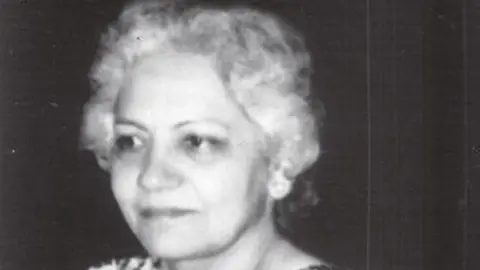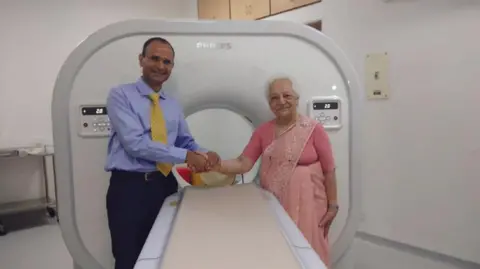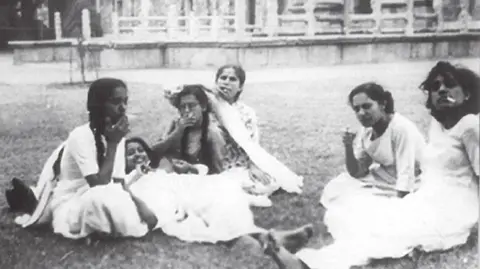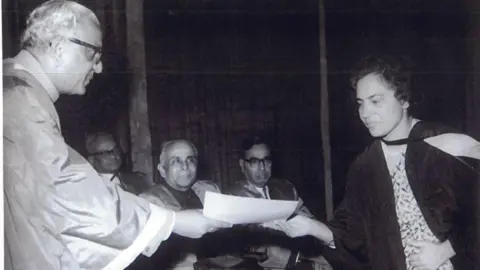A pioneering doctor remembers India leader Indira Gandhi's final moments
 Juggernaut Books
Juggernaut BooksNot much about Sneh Bhargava's life seems ordinary.
In 1984, she became the first woman to helm the All India Institute of Medical Sciences (AIIMS) in the capital Delhi - one of the country's top medical institutions - and in its almost 70-year history, remains the only woman to have done so.
At 90, Dr Bhargava - one of India's pioneering radiologists - began writing her memoir, The Woman Who Ran AIIMS, which was published earlier this month, and at 95, continues to remain an active member in the medical community.
From choosing radiology when it was still emerging in 1940s India to becoming one of its most well-known practitioners, Dr Bhargava's legacy is nothing short of extraordinary.
Not unlike her first day on the job as director-to-be of AIIMS, which was nothing short of a trial by fire.
It was the morning of 31 October 1984, and a meeting was under way at the hospital to confirm her appointment after India's then prime minister Indira Gandhi had selected her for the role.
 Juggernaut Books
Juggernaut BooksDr Bhargava was not part of the meeting, but was in her office reviewing medical cases for the day. She recalls in her memoir hearing a colleague frantically call out to her, asking her to rush to the casualty ward.
There, lying on a gurney was the very woman who had selected Dr Bhargava to head the hospital - Indira Gandhi. Her saffron sari was drenched in blood and she had no pulse.
"At the time, I didn't focus on it being the prime minister who was lying in front of me," Dr Bhargava told the BBC. "My first thoughts were that we had to help her and also protect her from further harm," she said.
Dr Bhargava was worried that a mob would storm the casualty ward, as a large crowd had already begun gathering outside the hospital.
News began to trickle out: Gandhi had been shot by two Sikh bodyguards in revenge for Operation Blue Star, the military raid on Amritsar's Golden Temple in June to flush out militants.
Gandhi's assassination sparked one of the deadliest riots India has seen, the beginnings of which Dr Bhargava began hearing about as she hastened to shift the prime minister to one of the building's top floors.
There, in the operating theatre, a Sikh doctor fled the room the minute he heard how Gandhi had died.
The news of her death had to be kept under wraps until her son, Rajiv Gandhi was sworn in as prime minister.
"Until then, our job, for the next four hours, was to keep up the charade that we were trying to save her life, when in fact she was dead when she was brought to AIIMS," Dr Bhargava writes.
 Juggernaut Books
Juggernaut BooksShe also described the harrowing process of embalming the prime minister's body, which would lie in state in the capital for two days before cremation.
"The embalming chemical, when we injected it into different main arteries, kept oozing out," Dr Bhargava writes. A ballistic report would later reveal that over three dozen bullets had punctured Gandhi's body.
But this wasn't the only remarkable episode in Dr Bhargava's long and illustrious career at AIIMS.
In the book she shares fascinating anecdotes of her interactions with other prominent politicians, including India's first prime minister, Jawaharlal Nehru.
She also recalls Sonia Gandhi bringing her son, a young Rahul to AIIMS after an arrow grazed his head while he was playing.
"Sonia Gandhi told me that she had to bring Rahul to us because Rajiv (her husband) was meeting the King of Jordan and the latter had given him a fancy car as a gift, which her husband was keen to drive," she writes in the book.
Rajiv Gandhi wanted to drive Rahul to AIIMS himself, without security, as a surprise - but Dr Bhargava firmly stopped him, citing safety concerns.
But not every day was as exciting.
Dr Bhargava recalls political pressure, including an MP who threatened her for not selecting his son-in-law for a job at AIIMS.
On another occasion, two top politicians, including the federal health secretary, tried to handpick the AIIMS dean - though the decision was hers alone.
Dr Bhargava says she stood firm against pressure, always prioritising patient care. She worked to establish radiology as a core part of diagnosis and treatment at AIIMS.
When Dr Bhargava joined in the 1960s, AIIMS had only basic imaging tools. She trained colleagues to read subtle signs in black-and-white X-rays, always in context with the patient's history. She later pushed for better equipment, helping build one of India's leading radiology departments.
 Juggernaut Books
Juggernaut BooksDr Bhargava was always drawn to making a difference.
Born in 1930 into an affluent family in Lahore in undivided India, as a child she loved playing doctor to her dolls and siblings. During the partition of India and Pakistan, Dr Bhargava's family fled to India and later, she would visit refugee camps with her father to help people.
At a time when few Indian women pursued higher education, Dr Bhargava studied radiology in London - the only woman in both her class and hospital department.
She returned to India in the 1950s after hearing from her mentor that the country was in need of skilled radiologists.
Dr Bhargava often credits her family, and her husband's liberal-mindedness for helping her achieve her dreams, and she hopes other Indian women find the same support.
"It starts from childhood," she says.
"Parents should support their daughters the same way they support their sons. Only then will they be able to break glass ceilings and reach for the stars."
Follow BBC News India on Instagram, YouTube, X and Facebook.
